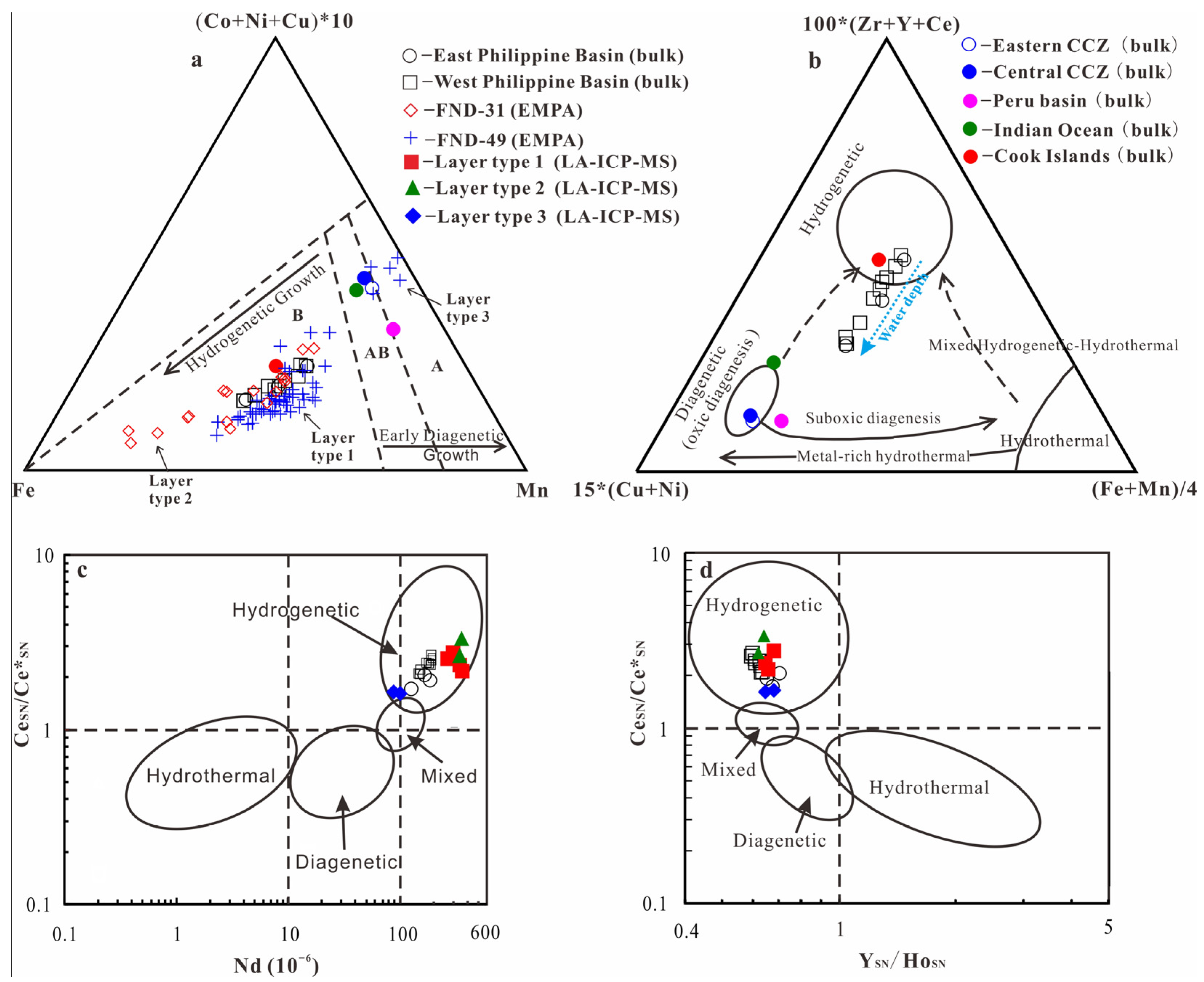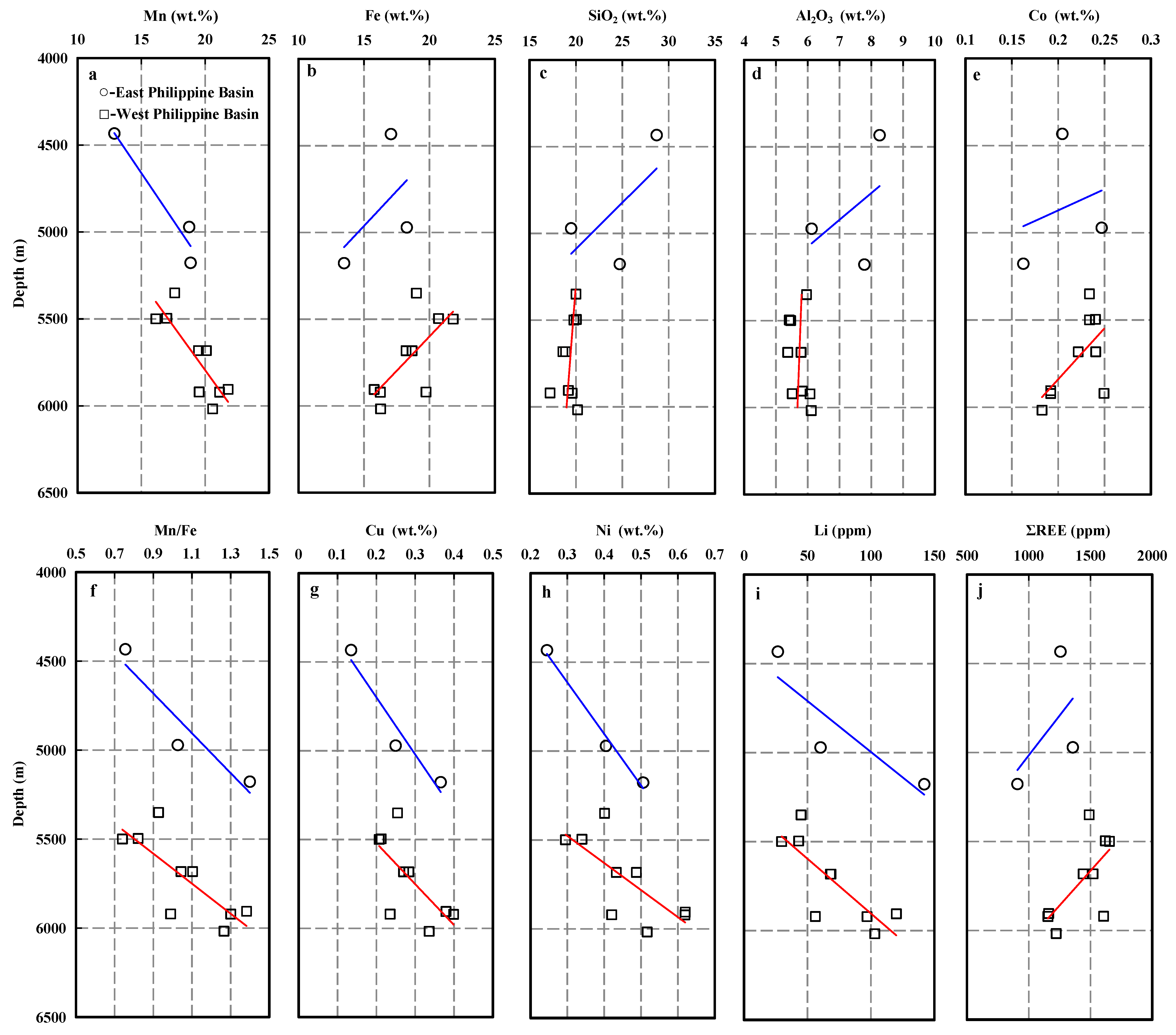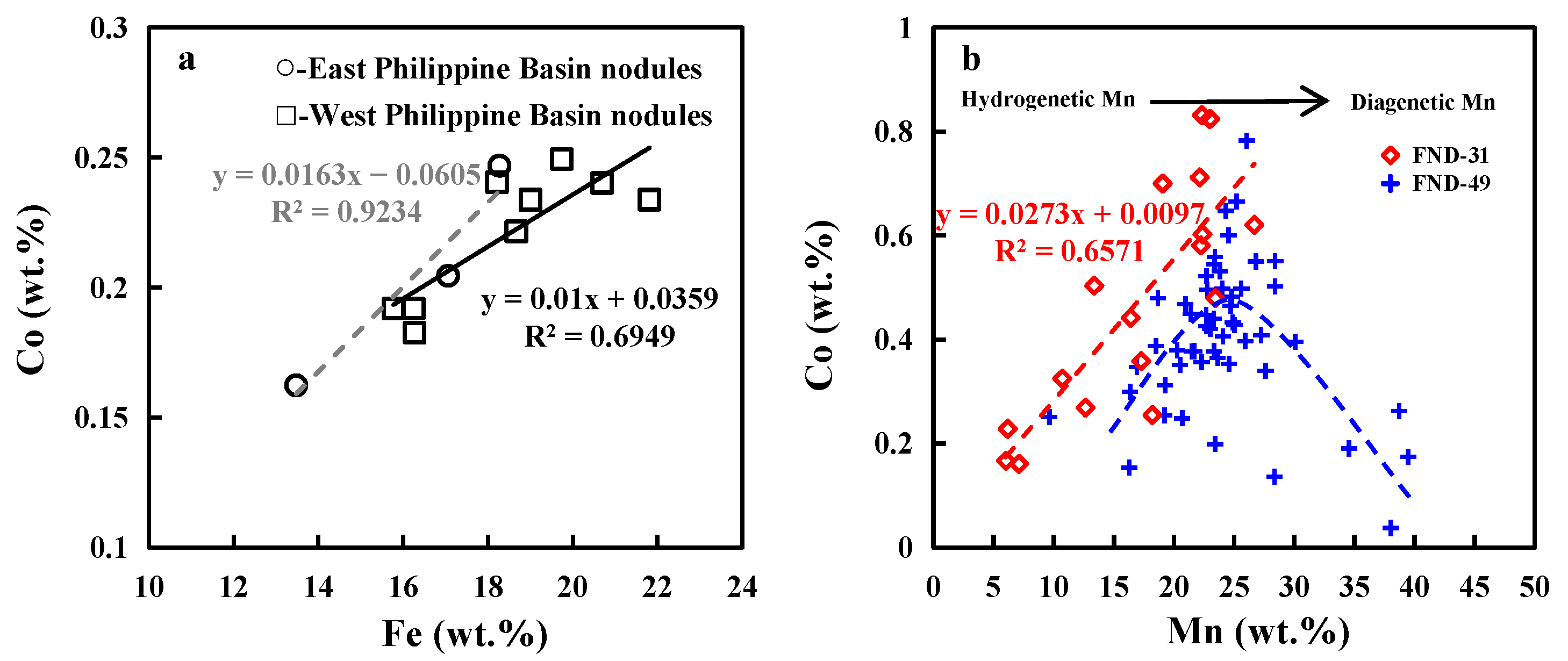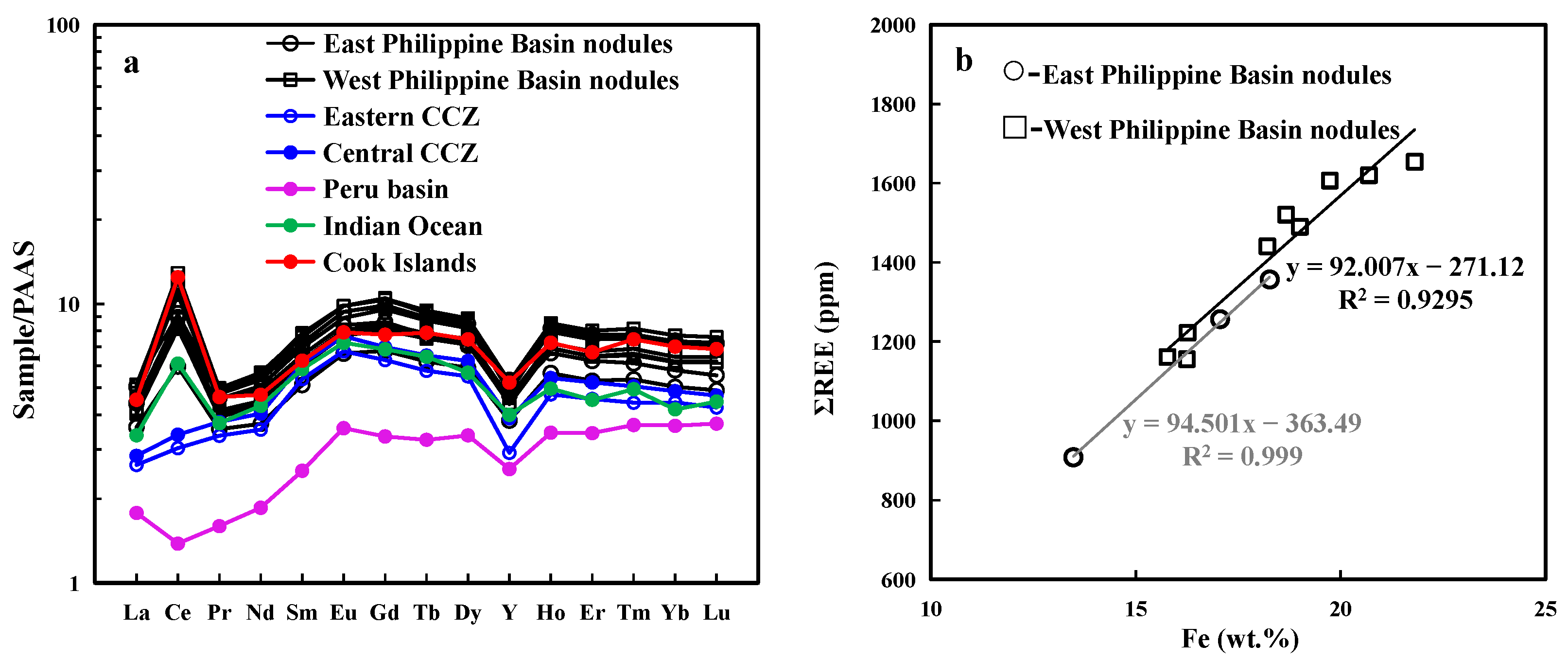Controls on Critical Metal Enrichments in Ferromanganese Nodules from the Philippine Sea, at Water Depths of 4400–6000 m
Abstract
1. Introduction
2. Materials and Methods
2.1. Sample Preparation
2.2. Analytical Methods
2.2.1. XRF and ICP-MS Analyses
2.2.2. BSE Images
2.2.3. EMPA Spot Analysis
2.2.4. In Situ LA-ICP-MS Analysis
3. Results
3.1. Bulk Nodules
3.2. Chemical Variation in Sublayers (EPMA and LA-ICP-MS Spot Analysis)
3.2.1. Layer Type 1 (Normal Mn/Fe Ratio)
3.2.2. Layer Type 2 (Fe-Rich; Low Mn/Fe Ratio)
3.2.3. Layer Type 3 (Mn-Rich; High Mn/Fe Ratio)
4. Discussion
4.1. Controls of the Different Genetic Processes
4.2. Effect of Water Depth: CCD and Diagenetic Orgin
4.3. The ‘Co Problem’: Co–Fe Correlation and Low Co Content
4.4. The Conundrum of REE Incorporation in the Nodules
5. Conclusions
Supplementary Materials
Author Contributions
Funding
Conflicts of Interest
References
- Hein, J.R.; Koschinsky, A. Deep-Ocean Fe–Mn Crust and Nodules. In Earth Systems and Environmental Sciences, Treatise on Geochemistry, 2nd ed.; Holland, H., Turekian, K., Eds.; Elsevier: Amsterdam, The Netherlands, 2013; pp. 273–291. [Google Scholar]
- Kuhn, T.; Wegorzewski, A.; Rühlemann, C.; Vink, A. Composition, Formation, and Occurrence of Polymetallic Nodules. In Deep-Sea Mining: Resource Potential, Technical and Environmental Considerations; Sharma, R., Ed.; Springer International Publishing: Berlin/Heidelberg, Germany, 2017; pp. 23–63. [Google Scholar]
- Hein, J.R.; Koschinsky, A.; Kuhn, T. Deep-ocean polymetallic nodules as a resource for critical materials. Nat. Rev. Earth Environ. 2020, 1, 158–169. [Google Scholar] [CrossRef]
- Marino, E.; González, F.J.; Lunar, R.; Reyes, J.; Medialdea, T.; Castillo-Carrión, M.; Bellido, E.; Somoza, L. High-Resolution Analysis of Critical Minerals and Elements in Fe–Mn Crusts from the Canary Island Seamount Province (Atlantic Ocean). Minerals 2018, 8, 285. [Google Scholar] [CrossRef]
- Kuhn, T.; Heller, C.; Kasten, S.; Koschinsky, A.; Versteegh, G.; Villinger, H. Niedrigthermale Fluidzirkulation an Seamounts und Störungszonen in 20 Mio. Jahre alter ozeanischer Kruste: Ergebnissse der Expedition SO240-FLUM. Statusseminar “Meeresforschung mit FS SONNE”. In Proceedings of the Tagungsband zum Statusseminar 2017 Meeresforschung mit FS Sonne, Oldenburg, Germany, 14–15 February 2017; pp. 30–34. [Google Scholar]
- Dutkiewicz, A.; Judge, A.; Müller, D. Environmental predictors of deep-sea polymetallic nodule occurrence in the global ocean. Geology 2020, 48, 293–297. [Google Scholar] [CrossRef]
- Josso, P.; Rushton, J.; Lusty, P.; Matthews, A.; Chenery, S.; Holwell, D.; Kemp, S.J.; Murton, B. Late Cretaceous and Cenozoic paleoceanography from north-east Atlantic Fe–Mn crust microstratigraphy. Mar. Geol. 2020, 422, 106122. [Google Scholar] [CrossRef]
- Ren, J.B.; Yao, H.Q.; Yang, Y.; Wang, L.X.; He, G.W.; Lai, P.X.; Zhou, J.; Deng, X.G.; Liu, S.J.; Deng, X.Z.; et al. Critical metal enrichment in atypical hydrogenetic Fe–Mn nodules: A case study in the Central Basin Ridge of the West Philippine Basin. Chem. Geol. 2023, 615, 121224. [Google Scholar] [CrossRef]
- González, F.J.; Somoza, L.; Hein, J.R.; Medialdea, T.; León, R.; Urgorri, V.; Reyes, J.; Martín-Rubí, J.A. Phosphorites, Co-rich Mn nodules, and Fe–Mn crusts from Galicia Bank, NE Atlantic: Reflections of Cenozoic tectonics and paleoceanography. Geochem. Geophys. Geosyst. 2016, 17, 346–374. [Google Scholar] [CrossRef]
- Marino, E.; González, F.J.; Somoza, L.; Lunar, R.; Ortega, L.; Vázquez, J.T.; Reyes, J.; Bellido, E. Strategic and rare elements in Cretaceous-Cenozoic cobalt-rich ferromanganese crusts from seamounts in the Canary Island Seamount Province (northeastern tropical Atlantic). Ore Geol. Rev. 2017, 87, 41–61. [Google Scholar] [CrossRef]
- Halbach, P.; Friedrich, G.; von Stackelberg, U. The Manganese Nodule Belt of the Pacific Ocean; Enke: Stuttgart, Germany, 1988; pp. 61–69. [Google Scholar]
- Wegorzewski, A.V.; Dutkiewicz, T. The influence of suboxic diagenesis on the formation of manganese nodules in the Clarion Clipperton nodule belt of the Pacific Ocean. Mar. Geol. 2014, 357, 123–138. [Google Scholar] [CrossRef]
- Usui, A.; Graham, I.J.; Ditchburn, R.G.; Zondervan, A.; Shibasaki, H.; Hishida, H. Growth history and formation environments of Fe–Mn deposits on the Philippine Sea Plate, Northwest Pacific Ocean. Isl. Arc. 2007, 16, 420–430. [Google Scholar] [CrossRef]
- Zhou, J.; Cai, P.J.; Yang, C.P.; Liu, S.F.; Luo, W.D.; Nie, X. Geochemical characteristics and genesis of Fe–Mn nodules and crusts from the Central Rift Seamounts Group of the West Philippine Sea. Ore Geol. Rev. 2022, 145, 104923. [Google Scholar] [CrossRef]
- Li, C.; Song, W.; Sun, Z.; Huang, W.; Hu, G.; Yuan, X.; Kao, S.-J. High-Resolution Analysis of Fe–Mn Oxyhydroxide in Ferromanganese Nodules from the Northwestern Pacific Ocean and Insights on Element Mobility. Minerals 2023, 13, 415. [Google Scholar] [CrossRef]
- Liu, Y.S.; Hu, Z.C.; Gao, S.; Günther, D.; Xu, J. In situ analysis of major and trace elements of anhydrous minerals by LA-ICP-MS without applying an internal standard. Chem. Geol. 2008, 257, 34–43. [Google Scholar] [CrossRef]
- Chen, L.; Liu, Y.S.; Hu, Z.C.; Gao, S.; Zong, K.Q.; Chen, H.H. Accurate determinations of fifty-four major and trace elements in carbonate by LA–ICP-MS using normalization strategy of bulk components as 100%. Chem. Geol. 2011, 284, 283–295. [Google Scholar] [CrossRef]
- Mclennan, S.M. Rare Earth Elements in Sedimentary Rocks: Influence of Provenance and Sedimentary Processes. In Geochemistry and Mineralogy of Rare Earth Elements; Lipin, B.R., McKay, G.A., Eds.; Mineralogical Society of America: Washington, MA, USA, 1989; Volume 21, pp. 169–200. [Google Scholar]
- Hein, J.R.; Spinardi, F.; Okamoto, N.; Mizell, K.; Thorburn, D.; Tawake, A. Critical metals in manganese nodules from the Cook Islands EEZ, abundances and distributions. Ore Geol. Rev. 2015, 68, 97–116. [Google Scholar] [CrossRef]
- Guan, Y.; Sun, X.M.; Shi, G.Y.; Jiang, X.D.; Lu, H.F. Rare earth elements composition and constraint on the genesis of the polymetallic crusts and nodules in the South China Sea. Acta Geol. Sin. Engl. Ed. 2017, 91, 1751–1766. [Google Scholar] [CrossRef]
- Knaack, D.; Sullivan, K.; Brown, D.; Langa, M.; Mathieu, J.; Bouchard, M.; Haring, M.; Petrus, J.; Stern, B.; Hein, J.; et al. Geochemical and mineralogical composition of Fe–Mn precipitates from the southern Mariana arc: Evaluation, formation, and implications. Chem. Geol. 2021, 568, 120132. [Google Scholar] [CrossRef]
- Ren, X.W.; Liu, J.H.; Shi, X.F.; Cui, Y.C.; Lin, X.H. Genesis and ore-forming stages of co-rich Fe–Mn crusts from seamount m of magellan seamounts: Evidence from geochemistry and co chronology. Mar. Geol. Quat. Geol. 2011, 31, 65–74. [Google Scholar] [CrossRef]
- Su, R.; Sun, F.Y.; Li, X.H.; Chu, F.Y.; Sun, G.S.; Li, J.; Wang, H.; Li, Z.G.; Zhang, C.; Zhang, W.Y.; et al. Diverse early diagenetic processes of Fe–Mn nodules from the eastern Pacific Ocean: Evidence from mineralogy and in-situ geochemistry. Int. Geol. Rev. 2022. ahead of print. [Google Scholar] [CrossRef]
- Bonatti, E.; Kraemer, T.; Rydell, H. Classification and genesis of submarine iron-manganese deposits. In Fe–Mn Deposits on the Ocean Floor; Horn, D.R., Ed.; NSF: Washington, DC, USA, 1972; pp. 149–166. [Google Scholar]
- Josso, P.; Pelleter, E.; Pourret, O.; Fouquet, Y.; Etoubleau, J.; Cheron, S.; Bollinger, C. A new discrimination scheme for oceanic Fe–Mn deposits using high field strength and rare earth elements. Ore Geol. Rev. 2017, 87, 3–15. [Google Scholar] [CrossRef]
- Bau, M.; Schmidt, K.; Koschinsky, A.; Hein, J.; Kuhn, T.; Usui, A. Discriminating between different genetic types of marine ferro-manganese crusts and nodules based on rare earth elements and yttrium. Chem. Geol. 2014, 381, 1–9. [Google Scholar] [CrossRef]
- Blöthe, M.; Wegorzewski, A.; Müller, C.; Simon, F.; Kunh, T.; Schippers, A. Manganese-cycling microbial communities inside deep-sea manganese nodules. Environ. Sci. Technol. 2015, 49, 7692–7700. [Google Scholar] [CrossRef]
- Hein, J.R.; Koschinsky, A.; Bau, M.; Manheim, F.T.; Kang, J.K.; Roberts, L. Co-rich Fe–Mn crusts in the Pacific. In Handbook of Marine Mineral Deposits; CRC Marine Science Series; Cronan, D.S., Ed.; CRC Press: Boca Raton, FL, USA, 2000; pp. 239–279. [Google Scholar]
- Hein, J.R.; Koschinsky, A.; Halbach, P.; Manheim, F.T.; Bau, M.; Kang, J.K.; Lubick, N. Iron and manganese oxide mineralization in the Pacific. Geol. Soc. Lond. Spec. Publ. 1997, 119, 123–138. [Google Scholar] [CrossRef]
- Wegorzewski, A.V.; Kuhn, T.; Dohrmann, R.; Wirth, R.; Grangeon, S. Mineralogical characterization of individual growth structures of Mn-nodules with different Ni + Cu content from the central Pacific Ocean. Am. Mineral. 2015, 100, 2497–2508. [Google Scholar] [CrossRef]
- Marino, E.; González, F.J.; Kuhn, T.; Madureira, P.; Wegorzewski, A.V.; Mirao, J.; Medialdea, T.; Oeser, M.; Miguel, C.; Reyes, J.; et al. Hydrogenetic, Diagenetic and Hydrothermal Processes Forming Ferromanganese Crusts in the Canary Island Seamounts and Their Influence in the Metal Recovery Rate with Hydrometallurgical Methods. Minerals 2019, 9, 439. [Google Scholar] [CrossRef]
- Halbach, P.; Hebisch, U.; Scherhag, C. Geochemical variations of Fe–Mn nodules and crusts from different provinces of the Pacific Ocean and their genetic control. Chem. Geol. 1981, 34, 3–17. [Google Scholar] [CrossRef]
- Hein, J.R.; Mizell, K.; Koschinsky, A.; Conrad, T.A. Deep-ocean mineral deposits as a source of critical metals for high- and green-technology applications: Comparison with land-based resources. Ore Geol. Rev. 2013, 51, 1–14. [Google Scholar] [CrossRef]
- Halbach, P.; Manheim, F.T. Potential of cobalt and other metals in Fe–Mn crusts on seamounts of the Central Pacific Basin. Mar. Mining. 1984, 4, 319–336. [Google Scholar]
- Halbach, P. Processes controlling the heavy metal distribution in pacific Fe–Mn nodules and crusts. Geol. Rundsch. 1986, 75, 235–247. [Google Scholar] [CrossRef]
- Usui, A.; Nishi, K.; Sato, H.; Nakasato, Y.; Thornton, B.; Kashiwabara, T.; Tokumaru, A.; Sakaguchi, A.; Yamaoka, K.; Kato, S.; et al. Continuous growth of hydrogenetic Fe–Mn crusts since 17 Myr ago on Takuyo-Daigo Seamount, NW Pacific, at water depths of 800–5500 m. Ore. Geol. Rev. 2017, 87, 71–87. [Google Scholar] [CrossRef]
- Koschinsky, A.; Hein, J.R. Marine Fe–Mn encrustations: Archives of changing oceans. Elements 2017, 13, 177–182. [Google Scholar] [CrossRef]
- Hein, J.R.; Koschinsky, A. Deep-ocean Fe–Mn crusts and nodules. In Treatise on Geochemistry; Scott, S., Ed.; Elsevier: New York, NY, USA, 2012; Volume 12. [Google Scholar]
- Hein, J.R.; Conrad, T.A.; Frank, M.; Christl, M.; Sager, W.W. Copper-nickel-rich, amalgamated Fe–Mn crust-nodule deposits from Shatsky Rise, NW Pacific. Geochem. Geophys. Geosyst. 2012, 13, Q10022. [Google Scholar] [CrossRef]
- Takahashi, Y.; Manceau, A.; Geoffroy, N.; Marcus, M.A.; Usui, A. Chemical and structural control of the partitioning of Co, Ce, and Pb in marine Fe–Mn oxides. Geochim. Cosmochim. Acta 2007, 71, 984–1008. [Google Scholar] [CrossRef]
- Manheim, F.T. Marine cobalt resources. Science 1986, 232, 600–608. [Google Scholar] [CrossRef] [PubMed]
- Halbach, P.E.; Jahn, A.; Cherkashov, G. Marine Co-Rich Fe–Mn Crust Deposits: Description and Formation, Occurrences and Distribution, Estimated World-wide Resources. In Deep-Sea Mining: Resource Potential, Technical and Environmental Considerations; Sharma, R., Ed.; Springer International Publishing: Berlin/Heidelberg, Germany, 2017; pp. 65–141. [Google Scholar]
- Halbach, P.; Segl, M.; Puteanus, D.; Mangini, A. Co-fluxes and growth rates in Fe–Mn deposits from central Pacific seamount areas. Nature 1983, 304, 716–719. [Google Scholar] [CrossRef]
- Sensarma, S.; Saha, A.; Hazra, A. Implications of REE incorporation and host sediment influence on the origin and growth processes of Fe–Mn nodules from Central Indian Ocean Basin. Geosci. Front. 2021, 12, 101123. [Google Scholar] [CrossRef]
- Koschinsky, A.; Halbach, P. Sequential leaching of marine Fe–Mn precipitates: Genetic implications. Geochim. Cosmochim. Acta 1995, 59, 5113–5132. [Google Scholar] [CrossRef]
- Koschinsky, A.; Hein, J.R. Uptake of elements from seawater by Fe–Mn crusts: Solid-phase associations and seawater speciation. Mar. Geol. 2003, 198, 331–351. [Google Scholar] [CrossRef]
- Li, D.; Fu, Y.; Liu, Q.; Reinfelder, J.R.; Hollings, P.; Sun, X.; Tan, C.; Dong, Y.; Ma, W. High-resolution LA-ICP-MS mapping of deep-sea polymetallic micronodules and its implications on element mobility. Gondwana Res. 2020, 81, 461–474. [Google Scholar] [CrossRef]
- Zhang, H.; Zhou, J.; Yuan, P.; Dong, Y.; Fan, W.; Chu, F.; Xiao, W.; Liu, D. Highly positive Ce anomalies of hydrogenetic ferromanganese micronodules from abyssal basins in the NW and NE Pacific: Implications for REY migration and enrichment in deep-sea sediments. Ore. Geol. Rev. 2023, 154, 105324. [Google Scholar] [CrossRef]
- Bau, M. Scavenging of dissolved yttrium and rare earths by precipitating iron oxyhydroxide: Experimental evidence for Ce oxidation, Y–Ho fractionation, and lanthanide tetrad effect. Goochim. Cosmochim. Acta 1999, 63, 67–77. [Google Scholar] [CrossRef]








| Samples | FND-11 | FND-12 | FND-29 | FND-31 | FND-32 | FND-36 | FND-37 | FND-39 | FND-43 | FND-47 | FND-48 | FND-49 |
|---|---|---|---|---|---|---|---|---|---|---|---|---|
| SiO2 (%) | 19.48 | 24.72 | 28.7 | 20.01 | 20.04 | 19.78 | 17.21 | 18.88 | 18.59 | 20.18 | 19.59 | 19.18 |
| Al2O3 | 6.12 | 7.78 | 8.26 | 5.96 | 5.42 | 5.46 | 5.51 | 5.37 | 5.79 | 6.11 | 6.07 | 5.83 |
| CaO | 2.6 | 2.18 | 2.31 | 2.32 | 2.22 | 2.2 | 2.36 | 2.21 | 2.32 | 2.21 | 2.18 | 2.22 |
| MgO | 2.41 | 2.79 | 2.23 | 2.32 | 2.15 | 2.1 | 2.31 | 2.28 | 2.49 | 2.46 | 2.71 | 2.73 |
| K2O | 0.83 | 1.34 | 1.61 | 0.88 | 0.78 | 0.77 | 0.73 | 0.78 | 0.8 | 0.91 | 0.88 | 0.9 |
| Na2O | 2.27 | 2.92 | 2.65 | 2.27 | 2.16 | 2.17 | 2.14 | 2.25 | 2.23 | 2.5 | 2.26 | 2.36 |
| TiO2 | 1.55 | 0.96 | 1.39 | 1.55 | 1.56 | 1.69 | 1.54 | 1.35 | 1.42 | 1.1 | 1.07 | 1.04 |
| P2O5 | 0.65 | 0.51 | 0.65 | 0.68 | 0.72 | 0.74 | 0.71 | 0.66 | 0.65 | 0.6 | 0.59 | 0.58 |
| MnO | 24.21 | 24.35 | 16.64 | 22.74 | 21.94 | 20.84 | 25.22 | 25.15 | 25.94 | 26.58 | 27.28 | 28.15 |
| TFe2O3 | 26.12 | 19.27 | 24.39 | 27.17 | 29.58 | 31.18 | 28.22 | 26.69 | 26.04 | 23.26 | 23.23 | 22.55 |
| LOI | 13.32 | 12.8 | 11.73 | 13.67 | 13.52 | 13.44 | 14.19 | 14.13 | 14.01 | 14.32 | 13.98 | 14.31 |
| Li (ppm) | 60.3 | 142 | 26.6 | 44.9 | 43 | 29.6 | 56.2 | 68.5 | 68.1 | 103 | 96.9 | 120 |
| Cu | 2497 | 3657 | 1351 | 2544 | 2124 | 2073 | 2354 | 2701 | 2837 | 3359 | 3989 | 3792 |
| Co | 2469 | 1624 | 2045 | 2337 | 2402 | 2338 | 2494 | 2216 | 2405 | 1826 | 1919 | 1919 |
| Ni | 4048 | 5057 | 2447 | 4011 | 3396 | 2950 | 4204 | 4329 | 4873 | 5168 | 6193 | 6199 |
| La | 193 | 138 | 168 | 183 | 190 | 190 | 196 | 190 | 178 | 157 | 154 | 160 |
| Ce | 736 | 474 | 713 | 885 | 988 | 1024 | 968 | 893 | 857 | 703 | 648 | 654 |
| Pr | 43.7 | 31.4 | 40.6 | 42 | 44 | 43.8 | 43.8 | 43.2 | 40.3 | 36.6 | 35.9 | 34.7 |
| Nd | 185 | 126 | 165 | 181 | 192 | 190 | 189 | 188 | 172 | 152 | 149 | 146 |
| Sm | 39.9 | 28.4 | 36.3 | 40.2 | 43 | 43.5 | 42.2 | 42.4 | 38.7 | 34.7 | 34.1 | 33.3 |
| Eu | 10.1 | 7.16 | 9.04 | 10.1 | 10.6 | 10.6 | 10.6 | 10.6 | 9.6 | 8.68 | 8.52 | 8.29 |
| Gd | 45.3 | 31.6 | 40.1 | 46 | 48.5 | 48.8 | 48.6 | 48.2 | 44.5 | 39.4 | 38.2 | 37.5 |
| Tb | 6.96 | 4.81 | 5.97 | 6.91 | 7.17 | 7.19 | 7.32 | 7.22 | 6.74 | 6.06 | 5.88 | 5.8 |
| Dy | 39.7 | 27.6 | 33.1 | 39.4 | 40.6 | 40.4 | 41.5 | 40.5 | 38.3 | 35 | 33.9 | 33.4 |
| Ho | 8.09 | 5.59 | 6.6 | 7.96 | 8.14 | 7.97 | 8.44 | 8.23 | 7.86 | 7.16 | 6.84 | 6.88 |
| Er | 22.1 | 15.1 | 17.8 | 21.3 | 21.6 | 21.3 | 22.8 | 22.1 | 21.2 | 19.2 | 18.5 | 18.4 |
| Tm | 3.14 | 2.17 | 2.48 | 3.11 | 3.11 | 3.04 | 3.3 | 3.14 | 3.06 | 2.79 | 2.68 | 2.65 |
| Yb | 20.8 | 14.2 | 16.3 | 20.6 | 20.4 | 20.1 | 21.7 | 20.7 | 20.4 | 18.2 | 17.5 | 17.4 |
| Lu | 3.12 | 2.12 | 2.4 | 3.06 | 3.06 | 3.06 | 3.29 | 3.14 | 3.11 | 2.78 | 2.67 | 2.68 |
| Y | 144 | 103 | 127 | 134 | 132 | 130 | 142 | 137 | 134 | 124 | 118 | 119 |
| ΣREE | 1356.9 | 908.2 | 1256.7 | 1489.6 | 1620.2 | 1653.8 | 1606.6 | 1520.4 | 1440.8 | 1222.6 | 1155.7 | 1161.0 |
| EuSN/Eu*SN | 1.11 | 1.11 | 1.11 | 1.09 | 1.08 | 1.07 | 1.09 | 1.09 | 1.08 | 1.09 | 1.1 | 1.09 |
| CeSN/Ce*SN | 1.9 | 1.71 | 2.05 | 2.39 | 2.56 | 2.66 | 2.47 | 2.34 | 2.4 | 2.2 | 2.07 | 2.08 |
| Element | Layer Type 1 | Layer Type 2 | Layer Type 3 | |||||||||
|---|---|---|---|---|---|---|---|---|---|---|---|---|
| Average | Max | Min | STD.DEV | Average | Max | Min | STD.DEV | Average | Max | Min | STD.DEV | |
| K | 0.36 | 0.82 | 0.21 | 0.12 | 0.24 | 0.33 | 0.19 | 0.06 | 0.50 | 0.74 | 0.17 | 0.24 |
| Ti | 1.03 | 1.63 | 0.58 | 0.25 | 1.33 | 1.65 | 1.08 | 0.21 | 0.21 | 0.58 | 0.05 | 0.22 |
| Ca | 2.30 | 2.70 | 1.45 | 0.26 | 0.92 | 1.15 | 0.67 | 0.20 | 1.42 | 2.20 | 0.97 | 0.52 |
| P | 0.37 | 0.47 | 0.18 | 0.06 | 0.33 | 0.41 | 0.24 | 0.06 | 0.08 | 0.17 | 0.03 | 0.05 |
| Pb | 0.18 | 0.27 | 0.05 | 0.06 | 0.19 | 0.28 | 0.14 | 0.06 | 0.04 | 0.08 | 0.00 | 0.03 |
| Na | 0.61 | 1.56 | 0.30 | 0.24 | 0.55 | 0.65 | 0.40 | 0.10 | 0.92 | 1.32 | 0.52 | 0.37 |
| Mg | 1.02 | 2.31 | 0.57 | 0.32 | 0.65 | 0.72 | 0.60 | 0.06 | 3.65 | 3.80 | 3.35 | 0.18 |
| Al | 2.09 | 3.89 | 1.41 | 0.42 | 1.50 | 1.76 | 1.32 | 0.16 | 2.88 | 4.70 | 2.10 | 1.04 |
| Si | 4.98 | 10.37 | 3.10 | 1.34 | 4.74 | 6.37 | 3.30 | 1.10 | 2.53 | 3.69 | 1.31 | 1.02 |
| Mn | 22.67 | 30.09 | 12.65 | 3.44 | 8.68 | 13.37 | 6.03 | 3.24 | 35.82 | 39.47 | 28.35 | 4.58 |
| Fe | 22.42 | 29.06 | 15.72 | 3.10 | 24.66 | 29.76 | 18.82 | 4.55 | 3.60 | 7.11 | 0.82 | 2.39 |
| Co | 0.46 | 0.83 | 0.15 | 0.14 | 0.28 | 0.50 | 0.16 | 0.14 | 0.16 | 0.26 | 0.04 | 0.08 |
| Ni | 0.32 | 1.16 | 0.11 | 0.23 | 0.06 | 0.14 | 0.01 | 0.05 | 2.29 | 2.83 | 1.83 | 0.45 |
| Cu | 0.18 | 0.60 | 0.04 | 0.12 | 0.08 | 0.14 | 0.03 | 0.04 | 0.85 | 0.90 | 0.71 | 0.08 |
| Mn/Fe | 1.05 | 1.91 | 0.44 | 0.29 | 0.37 | 0.62 | 0.22 | 0.16 | 17.29 | 46.37 | 4.86 | 16.92 |
| Ni + Cu | 0.50 | 1.76 | 0.21 | 0.34 | 0.15 | 0.28 | 0.07 | 0.08 | 3.14 | 3.72 | 2.69 | 0.47 |
Disclaimer/Publisher’s Note: The statements, opinions and data contained in all publications are solely those of the individual author(s) and contributor(s) and not of MDPI and/or the editor(s). MDPI and/or the editor(s) disclaim responsibility for any injury to people or property resulting from any ideas, methods, instructions or products referred to in the content. |
© 2023 by the authors. Licensee MDPI, Basel, Switzerland. This article is an open access article distributed under the terms and conditions of the Creative Commons Attribution (CC BY) license (https://creativecommons.org/licenses/by/4.0/).
Share and Cite
Li, C.; Song, W.; Sun, Z.; Hu, G.; Yuan, X.; Kao, S.-J. Controls on Critical Metal Enrichments in Ferromanganese Nodules from the Philippine Sea, at Water Depths of 4400–6000 m. Minerals 2023, 13, 522. https://doi.org/10.3390/min13040522
Li C, Song W, Sun Z, Hu G, Yuan X, Kao S-J. Controls on Critical Metal Enrichments in Ferromanganese Nodules from the Philippine Sea, at Water Depths of 4400–6000 m. Minerals. 2023; 13(4):522. https://doi.org/10.3390/min13040522
Chicago/Turabian StyleLi, Chao, Weiyu Song, Zhenjun Sun, Gang Hu, Xiaojun Yuan, and Shuh-Ji Kao. 2023. "Controls on Critical Metal Enrichments in Ferromanganese Nodules from the Philippine Sea, at Water Depths of 4400–6000 m" Minerals 13, no. 4: 522. https://doi.org/10.3390/min13040522
APA StyleLi, C., Song, W., Sun, Z., Hu, G., Yuan, X., & Kao, S.-J. (2023). Controls on Critical Metal Enrichments in Ferromanganese Nodules from the Philippine Sea, at Water Depths of 4400–6000 m. Minerals, 13(4), 522. https://doi.org/10.3390/min13040522





